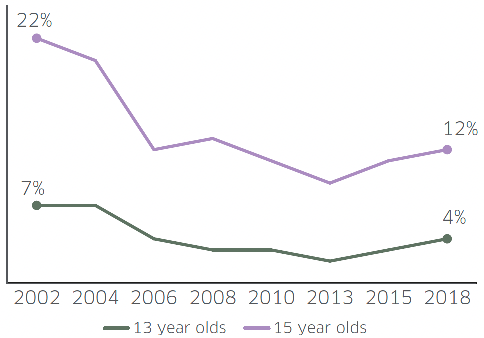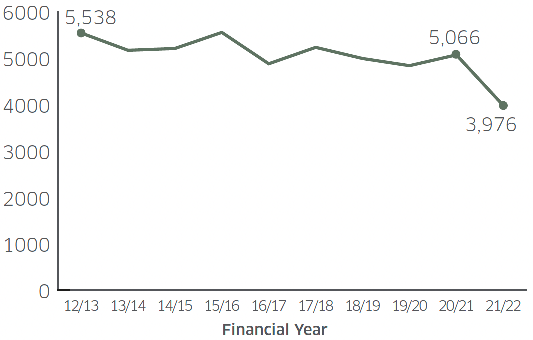National Mission on Drugs: annual report 2021 to 2022
Sets out the progress made between January 2021 and 31 March 2022 by national government, local government and third sector partners towards reducing drug deaths and improving the lives of those impacted by drugs in Scotland.
3. Outcome 1: Fewer People develop Problem Drug Use
3.1 Overview
This outcome focusses on fewer people developing problem drug use, education and prevention, early access to support for emerging problem drug use and reducing the supply of harmful drugs.
Prevention where possible is the best intervention. Effective prevention requires a whole-systems response and our approach sits within the government's wider commitment to address inequalities and the wider social determinants of health.
A comprehensive approach to early intervention for young people sits alongside our Whole Family Approach Framework (See Outcome 6), to support the delivery of The Promise by making significant change in the way services work with families. This is supported by an additional £6.5 million funding - £3.5 million directly to ADPs and £3 million for the Children and Families Fund.
3.2 Progress in 2021-22
3.2.1 Early Intervention and Prevention
A working group on Early Interventions for Children and Young People (EICYPWG) first met in June 2021. The group includes a range of experts from drug and alcohol and young people's support services.
From June 2021 to March 2022, the focus of the group was to scope the size of the problem and gather data, the Young people experiencing harms from alcohol and drugs: literature and evidence review was published in November 2021. This work was completed in July 2022 and the group are now working towards developing standards for services by taking a co-design approach.
The National Mission funded five Children and Families projects through the Corra Foundation awarding multi-year funding totalling £2,317,657 (£412,236 in 2021/22). These projects include 'The Corner', based in Dundee City who will support young people who are finding it difficult to manage their accommodation.
A further 18 projects were granted funding of £1,609,217 for 2022/23, project details can be found on the Corra Foundation website.
In addition PHS are leading the development of a consensus statement on substance use prevention. The consensus statement will gather views of experts on essential components of a system to prevent substance use and harms. This will then be used to support the planning and delivery at a national and local level, allowing us to develop a national prevention strategy.
3.2.2 Tackling Child Poverty
Child poverty is one of the underlying risk factors for problem substance use.[8] Over 2021-22, Scottish Government took a range of actions to continue delivering progress against our first tackling child poverty delivery plan, Every Child, Every Chance (2018-22). Actions included, delivering on our commitment to offer 1140 hours of funded Early Learning and Childcare; delivering 9,757 affordable homes (part of the more than 100,00 affordable homes delivered since 2007); extending concessionary travel to under 22s; and rolling out a £41 million Winter Support Fund.
In March 2022, we published our second tackling child poverty delivery plan - Best Start, Bright Futures (2022-26) - to drive further progress towards our ambitious child poverty targets. The plan sets out our new employability offer with holistic support from a dedicated key worker, linked to support for more accessible, affordable childcare and transport. It also commits to further increasing the Scottish Child Payment to £25 when it is extended to eligible under 16s at the end of the year, and improving access to warm, affordable homes.
Core to 'Best Start, Bright Futures' approach is focusing on whole system change – including through place-based 'Pathfinders' - and transforming our ways of working so that we deliver holistic, person-centred support to families where and when they need it. This approach enables a shift from addressing the consequences of poverty to preventing poverty. Action to provide this holistic, person-centred support will contribute to the delivery of both National Missions on tackling child poverty and on drugs.
3.2.3 Tackling supply of harmful drugs
Scottish Government has been exploring avenues to legislation to curtail illicit usage of industrial pill presses and we will continue to engage with UK government on this issue.[9]
3.3 Measuring Progress
This section presents some of the latest data and potential indicators in relation to Outcome 1 (fewer people develop problem drug use). It summarises what the available data and evidence tells us about the direction of travel and provides an indication of how progress may be measured.
3.3.1 Measuring progress: Prevalence of problem drug use
As a hidden population, measuring how many people use drugs problematically in Scotland is challenging – figures can only ever be estimates, combining available data on observed cases with an estimate of the unknown population.
The number of individuals with problem opiate and/or benzodiazepine use in Scotland was estimated to be 57,300 (95% confidence interval 55,800 to 58,900) during 2015/16, approximately 1.6% of the population.[10] This national prevalence rate is lower than was observed for 2012/13 in the previous study. However, changes to some of the data and methodology mean that direct comparisons with the results from previous years are difficult to interpret and it is not possible to conclude that a real reduction occurred.
In December 2021 Scottish Government announced funding of £382,000 for a three year collaboration between Public Health Scotland and the University of Bristol to deliver an up to date picture of the size and characteristics of problematic drug use in Scotland. The project will use data from the Scottish Public Health Drug Linkage Programme and a new methodology developed by the University of Bristol that has been validated and used successfully in a number of other countries and contexts. The outputs from this work – scheduled for 2022/23 and 2024/25 – will provide a key measure of progress.[c]
57,300 Estimated number of individuals with problem drug use in Scotland during 2015/16
3.3.2 Measuring progress: Substance use amongst children and young people
The most recent data available in relation to substance use amongst children and young people is several years old. Work is underway to address this – Scotland's Health and Wellbeing Census,[d] which took place for the first time during the 2021-22 academic year, will help us better understand children and young people's use of drugs and will provide insight into progress towards Outcome 1. Results from this are due in February 2023. In the interim, here we draw on the most recent available data and evidence to provide relevant context.
Scottish Schools Adolescent Lifestyle and Substance Use Survey (SALSUS)
The most recent Scottish Schools Adolescent Lifestyle and Substance Use Survey (SALSUS)[11] describes the prevalence of drug use amongst adolescents in 2018 and the trends over time. In 2018, 4% of 13 year olds and 12% of 15 year olds reported using drugs in the last month. Drug use in the last month has been gradually decreasing since 2002 (Figure 3).

Source: Scottish Government, Scottish Schools Adolescent Lifestyle and Substance Use Survey (SALSUS): drug use report 2018, Scottish Government, 2019 (National Statistics)
Pupils who had used drugs were most likely to say that they would go to either a friend or a parent if they wanted more information about drugs. Two thirds (66%) of pupils from each age group had received lessons, videos/DVDs or discussions in class about drugs. The majority of pupils thought that their school was providing them with enough advice and support about taking drugs (69% of 13 year olds and 62% of 15 year olds).
3.3.3 Measuring progress: Tackling supply of harmful drugs
Crime statistics give some insight into progress towards tackling the supply of harmful drugs but care should be taken in interpreting the figures.
Recorded crime – drug supply
Recorded crime statistics provide a measure of the volume of criminal activity with which the police are faced but do not reveal the incidence of all crime committed as not all crimes are reported to the police. In 2021/22, there were 3,976 recorded crimes related to the Supply of Drugs.[12] Over the ten year period from 2012/13 to 2021/22 the number of crimes recorded in this category decreased by 28%. This includes a 22% decrease in the most recent year, although the COVID-19 pandemic is likely to have had a significant impact on the type and volume of crime recorded throughout 2020/21 and 2021/22.

Source: Scottish Government, Recorded Crime in Scotland 2021-22, 2022 (National Statistics)
Drug seizures
The quantity of drugs seized by the police can fluctuate considerably each year as figures can be greatly influenced by a small number of large seizures. For crimes of drug supply.[e]
- The main Class A drugs seized by Police Scotland in 2019/20 were heroin (223 kilograms) and cocaine (131 kilograms). Police Scotland also seized approximately 28,800 ecstasy-type tablets.
- The main Class B drugs seized by Police Scotland in 2019/20 were herbal cannabis (921 kilograms), cannabis resin (649 kilograms) and amphetamines (143 kilograms). They also seized more than 33,000 cannabis plants.
- For Class C drugs, the main drugs seized were 4.9 million benzodiazepine tablets (the vast majority of which were etizolam).[13]
Between January 2020 and March 2022, Police Scotland recovered a total of 24 pill presses in Scotland.[14]
Contact
There is a problem
Thanks for your feedback